|
< Earlier Kibitzing · PAGE 196 OF 235 ·
Later Kibitzing> |
May-18-10
 | | sbevan:  <chesstoplay: <Sbevan> <30.Rxb2 Qxb2 31.Qh4>
And you asked, what does Black play. <chesstoplay: <Sbevan> <30.Rxb2 Qxb2 31.Qh4>
And you asked, what does Black play.
31. ..... Bb4 seems like a big thorn in our side.>
32.Bxb4 Qb4+
33. Kd1 Qxa4+
34 Bc2 and Black runs out of checks
With
A the R on g6 under attack
B the N on f6 under attack
I'll take White any day of the week on this. |
|
May-18-10
 | | sbevan:  I omitted the central pawn mass on e3 and d4, which if Black successfully exchanges down could be used as a major threat I omitted the central pawn mass on e3 and d4, which if Black successfully exchanges down could be used as a major threat |
|
| May-18-10 | | blue wave:  <Sbevan> I had a quick look at your line. I don't have much time. <Sbevan> I had a quick look at your line. I don't have much time. I came up with this.
30.Rxb2 Qxb2 31.Qh4 Bb4 32.Bxb4 Qxb4+ 33.Kd1 Qxa4+ 34.Bc2 Qa1+ 35.Nc1 Bg4+ 36.Kd2 and white does seem to be out of trouble. And black is out of immediate checks. 
click for larger view |
|
| May-18-10 | | benjinathan:  <hms123> is an avid endgame player and student. <hms123> is an avid endgame player and student. |
|
| May-18-10 | | hms123:  <benjinathan> I do have a lot of references that might prove helpful. If we get to that point, I will try to post more. <benjinathan> I do have a lot of references that might prove helpful. If we get to that point, I will try to post more. I am following the game closely and voting on every move. The main analysts are dong a fantastic job, and the spreadsheet is a lifesaver. |
|
| May-18-10 | | chesstoplay:  Hi < Sbevan > Hi < Sbevan >
Here's the move order from your last post: <30. Rxb2 Qxb2
31. Qh4 Bb4
32. Bxb4 Qb4+
33. Kd1 Qxa4+
34. Bc2 ..... >
And it is Black to play.
I think Black sticks it to us with
34. ... Bb3.
The "re-pin" or double pin takes away the attack on the Rook. If we played
35. R x N,
35. ..... B x B + forces a King move.
Let me stop here.
The problem I see is that after one of the checks from Black, we must use a move to get out of check -- then we lose our Rook, too. You pick the King move for White and I'll push on after that for Black. I'll gladly work/play through the line with you,
until we prove it one way or the other. |
|
| May-18-10 | | galumph:  Dan. Why not 30. Rxf6 Rxb1 31. Bxb1 Rxf6 32. Qg2+ Kf8 33. Bh7 as you suggest? Then if 33... h5 34 Nf4 Dan. Why not 30. Rxf6 Rxb1 31. Bxb1 Rxf6 32. Qg2+ Kf8 33. Bh7 as you suggest? Then if 33... h5 34 Nf4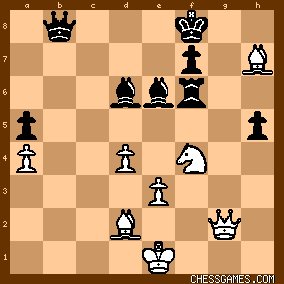
click for larger view |
|
| May-18-10 | | capafan:  Endgame Study: Endgame Study:

click for larger viewWhite to play...
A possible scenario for us in this game.
Assumptions:
We have traded one set of rooks, the DSBs and the a-pawns. White still has the connected central pawns and we have been able to march our h-pawn to the 2nd rank. Issues:
If we merely use the h-pawn to queen solely to trade it for the WN or WB, we are left with the very real possibility of ultimately facing a KRB v. KB/KN no-pawn endgame that is very difficult to win even with an endgame table base (not allowed). The f-pawn is needed to trade off the e-pawn once it advances. Therefore, we must find a way to ** safely ** queen the h-pawn. Problem:
First, identify the proper piece set-up for black (using only the pieces shown in the above diagram) that would allow safely queening the h-pawn. Second, identify a realistic line of moves which might lead to such a scenario as you have identified. To allow everyone to participate, please do not post your answer until tomorrow, but merely post a note saying you have figured the puzzle out. Good Luck! |
|
| May-18-10 | | crawfb5:  <capafan> I have an idea, but I am off to work in a few minutes, so I have not had time to check it very thoroughly. I have the day off tomorrow, so I will see what others suggest. <capafan> I have an idea, but I am off to work in a few minutes, so I have not had time to check it very thoroughly. I have the day off tomorrow, so I will see what others suggest. |
|
| May-18-10 | | benjinathan:  SPOILER ALERT!! SPOILER ALERT!!
READ NO FURTHER IF YOU WANT TO TRY TO SOLVE THE <capa> STUDY WITHOUT
THE INFLUENCE OF LUNATIC ANALYSIS.
Principles in play:
1) We need to try to exchange bishops in such a fashion that there is insufficient time for the knight to come over and guard the promotion square. 2) Must be careful of the potential for a knight fork on b5 3) Must be wary of the white connected pawns. But there is a lot of time to spare. The easiest way to achieve the B exchange is by moving our king next to our bishop on the promotion diagonal. There are essentially two places where that can be achieved. 1) in the a-c files on the 5-8 ranks.
2) in the g-h files on the 2-3 ranks
At first glance the idea of getting the king to the a-c files and moving the Bishop there seems safest because the king is nearly there already and can stop the d pawn at the same time . But on further review I am not convinced. It is slow and creates a bunch up of pieces which could be vulnerable to knight forks. I therefore prefer trying to get the king to the bottom right hand corner of the board (from the white perspective g-h files). The most forcing way to do that may be f6! After exf our king begins its journey Ke6 and then after taking the f pawn eventually winding its way to the right corner. It all depends on whether the king can safely and quickly take the f pawn. If it can, this might work. I am going to play it out with my kid tonight to see how it goes and will report back tomorrow. |
|
| May-18-10 | | WinKing:  <benjinathan:The most forcing way to do that may be f6! After exf our king begins its journey Ke6 and then after taking the f pawn eventually winding its way to the right corner.> <benjinathan:The most forcing way to do that may be f6! After exf our king begins its journey Ke6 and then after taking the f pawn eventually winding its way to the right corner.>Hint:Don't move(give up) the 'f' pawn unless necessary. If we give up the 'h' pawn the 'f' pawn may end up being our ticket
to the win. :) |
|
| May-18-10 | | DanLanglois:  <galumph>, 33...Qb2 threatens mate & in short, I think White can resign. <galumph>, 33...Qb2 threatens mate & in short, I think White can resign. |
|
May-18-10
 | | sbevan:  < chesstoplay: Hi < Sbevan > < chesstoplay: Hi < Sbevan >Here's the move order from your last post: <30. Rxb2 Qxb2
31. Qh4 Bb4
32. Bxb4 Qb4+
33. Kd1 Qxa4+
34. Bc2 ..... >
And it is Black to play.
I think Black sticks it to us with
34. ... Bb3.
The "re-pin" or double pin takes away the attack on the Rook. If we played
35. R x N,
35. ..... B x B + forces a King move.
Let me stop here.
The problem I see is that after one of the checks from Black, we must use a move to get out of check -- then we lose our Rook, too. You pick the King move for White and I'll push on after that for Black. I'll gladly work/play through the line with you,
until we prove it one way or the other.>
Good, very good and thank you!
You're right, in this line 34.Bc2 doesn't work. Good analysis I missed the re-pin. Glad to work it through with you.so after 33...Qxa4+ his majesty has to go to a black square. The choices i see:
c1
d2
e1 c1
34.Kc1 Qa3+
35. Kd2 (forced) Qb4+ perhaps
36.Kc1 forces a draw if repeated.
d2
34. Kd2 Qb4+
35.Kc1 etc.
OR
34. Kd2 Qb4+
35.Nc3 doesn't work....
e1
34.Ke1 Qb4+
35. Kd1
and 35..Bb3+
36.Bb2
and maybe Black doesn't run out of checks but doesn't win either. |
|
| May-18-10 | | benjinathan:  SPOILER ALERT SPOILER ALERT
<Hint:Don't move(give up) the 'f' pawn unless necessary.> I am sure you are right, but in the games with my kid he could not win after f6. The King made its way to the g and h files and forced the exchange of bishops. Sample line (50 as a random start point):
50.Kd2 f6 51.exf6 Ke6 52.Bd5 Kxf6
53. Ne2 Kg5 54. Ra1 Kh4 55.Ba2 Bg4 56. Ke1 Bf3 57.Kf2 BxB 58.KxB Ra2 59.Kh2 RxNe2 0-1 Demolish away! I have a thick skin. |
|
| May-18-10 | | chesstoplay:  Hi < Sbevan > Hi < Sbevan >
Thanks for your lines! I'm reviewing, but as I've gone back, I am not sure that Qh4 works.
It seems to be the root of the current board problems I keep having. I'm going to keep pushing pieces around for a bit, but take a look, too. |
|
| May-19-10 | | WinKing:  <benjinathan> I am confused starting with your move 54. :/ Maybe a typo(or a missed move) as white has no rooks. <benjinathan> I am confused starting with your move 54. :/ Maybe a typo(or a missed move) as white has no rooks. |
|
| May-19-10 | | benjinathan:  <WinKing> Crud!. Sorry, can;t read my own handwriting. Should be Kd1: <WinKing> Crud!. Sorry, can;t read my own handwriting. Should be Kd1:50.Kd2 f6 51.exf6 Ke6 52.Bd5 Kxf6
53. Ne2 Kg5 54. Kd1 Kh4 55.Ba2 Bg4 56. Ke1 Bf3 57.Kf2 BxB 58.KxB Ra2 59.Kh2 RxNe2 0-1 |
|
| May-19-10 | | crawfb5:  I saw <capa's> study post shortly before dashing off to work yesterday. I thought about it some during slack periods, and despite misremembering the positions of the BK and BR, it still helped me think about possibilities. I saw <capa's> study post shortly before dashing off to work yesterday. I thought about it some during slack periods, and despite misremembering the positions of the BK and BR, it still helped me think about possibilities.Upon rereading the post, I am unsure if <capa> meant to imply there was a definite winning line as in a formal problem or not, but I will plunge ahead with a few observations anyway. <capa's> position, White to move: 
click for larger view1. Be4?? loses immediately to either 1...Rxc3+ or to 1...h1=Q (the WB is pinned), so either 1. Kc4 or 1. Kd2 is necessary. I'd think 1. Kd2 more likely (unless I've overlooked some resource in 1. Kc4), so I'll go with that. I thought at first there might be a way to win the Bishop ending after 1...Rxc3 2. Kxc3, but that's probably too quick to give back the exchange. Of course, we should be open to the possibility of doing so under favorable circumstances. One assumption of <capa's> post was that we might not be able to allow White to give up a minor piece for the h-pawn. Suppose we gave up the Rook and h-pawn for White's Bishop and Knight. We might have something along the lines of: 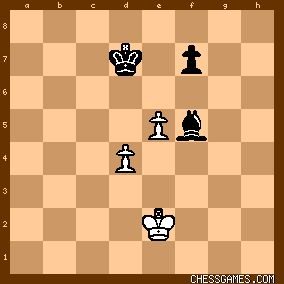
click for larger viewwhich should be an easy win. Anyway, after 1. Kd2 I was thinking along the lines of 1...Ra1 2. Ne2 (not 2. Ke2? Bg4) Rf1 3. Bb7 Bg4 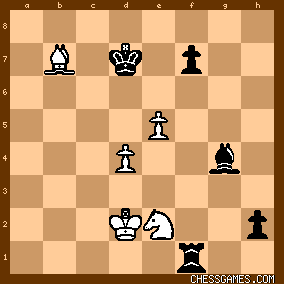
click for larger view4. Ng3 (if 4. Ke3 Bxe2 5. Kxe2 h1=Q 1-0) Bf3 5. Bxf3 Rxf3 6. Nh1 Rf1 7. Ng3 h1=Q 1-0. Not necessarily the only road to Rome, and not necessarily all forced, just wanted to suggest a few ideas. |
|
| May-19-10 | | benjinathan:  Other than white not taking the f pawn the first point of possible divergence from my line is at 53. Other than white not taking the f pawn the first point of possible divergence from my line is at 53. 50.Kd2 f6 51.exf6 Ke6 52.Bd5+ Kxf6 *
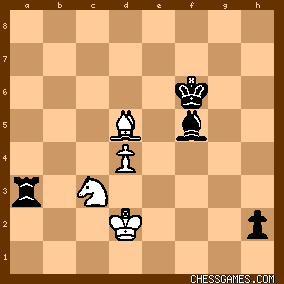
click for larger viewMy kid played 53. Ne2 in all the times we played through it ( I think because it put the horse in a position to take on h1), but 53.Nd1 might be good because it also can cover the promotion square from f2 and also at least potentially blocks the first rank fom the rook. 
click for larger view |
|
| May-19-10 | | capafan:  Thanks to all who participated in my little endgame study...my goal was merely to develop some free thought into a possible strategy going forward. My answer, which I am sure is not the only answer involves placement of the BR and BLSB as follows: Thanks to all who participated in my little endgame study...my goal was merely to develop some free thought into a possible strategy going forward. My answer, which I am sure is not the only answer involves placement of the BR and BLSB as follows:
click for larger viewKc4 Ke7
Kb4 Ra1
Nd5+ Kd8
Ne3 Bh3
Kc3 Rg1
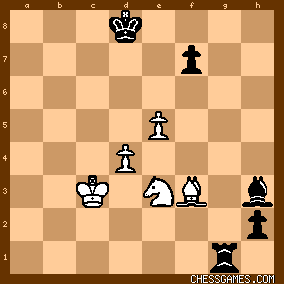
click for larger viewKd2 Bg2 0-1
Once the BLSB can move to g2, game over. The key to the above placement is that the BR cannot ever be taken because only the WN could take it (dark square, cannot be taken by WLSB and protected by pawn, cannot be taken by WK, and if taken by WN, pawn queens and cannot be taken. There may be instances (WK on f2 and WN on e2) that might work for white, however it would require ** all ** black's pieces and K working together; then, the BK merely marches down and munches white's pawns. The latter position would probably not work for white either as both WN and WLSB must be placed to prevent Bg2 and the WN cannot both do this and
be in a place to take the WR. |
|
| May-19-10 | | WinKing:  Proper piece set up that will allow black to queen safely: Proper piece set up that will allow black to queen safely: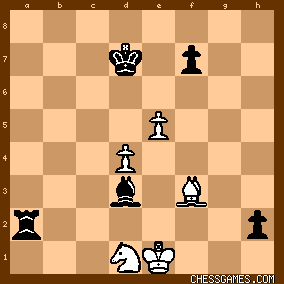
click for larger viewHow to get there - position after ...Bf5+:

click for larger view1.Kd2<(forced-1.Kc4 Ra1 & black wins quickly)> 1...Ra1 <(threatens h1(Q))> 2.Nd1 Ra2+
3.Ke1 <(pretty much forced if 3.Kc1 Rc2+ ;if 3.Kc3 or 3.Ke3 then 3...Ra3+ followed by 4...Rxf3)> 3...Bd3! <(key move freezing white's king-first Diagram above)> 4.Nf2 <(if 4.Ne3 Re2+; if 4.Nc3 Rf2 5.Nd1 or Ne4 5...Re2+ wins)> 4...Bc4
5.Ng4 <(if 5.d5 Ra3 6.Bh1 (not 6.Be4 Re3+! followed by Rxe4) Re3+ 7.Kd2 Re2+ wins;if 5.Bh1 Ke6)> 5...Ke6 <(5...Ra1+ works also)> 6.Bb7 <(anything better?)> 6...Re2+
7.Kd1 Rb2 <(is winning with ...Bd5 threatened)> 
click for larger viewThis was done quickly & I didn't triple check everything so there could be a hole somewhere (or a critical line missed). I did omit some winning lines I thought were obvious. Black should win with this position though I believe. There are some neat tricks that can arise such as this line: 1.Kd2 Ra1
2.Nd1 Ra2+
3.Ke1 Bd3
4.Nc3 Rc2
5.Nd1 Re2+
6.Kf1 Be4! wins

click for larger view |
|
| May-19-10 | | capafan:  <WinKing>Impressive! But I would not expect anything less. <WinKing>Impressive! But I would not expect anything less.<Kd2 <(forced-1.Kc4 Ra1 & black wins quickly)> is the line I showed. Now all we must do is determine how to get from: 30.Rxf6 Rxb1+
31.Bxb1 Rxf6
32.Qh7+ Kf8
33.Qh8+ Ke7
34.Qxb8 Bxb8
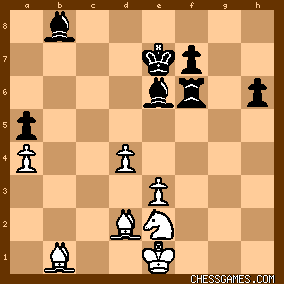
click for larger viewto:

click for larger viewor something similar. |
|
| May-19-10 | | WinKing:  <capafan> a couple of good games at the U.S. Championship today. <capafan> a couple of good games at the U.S. Championship today.Nakamura vs. Kraai &
Christiansen vs. Krush
Both Jesse Kraai & Irina Krush have been playing some inspiring chess. I have always had a soft spot for the underdog so I will be rooting for these two 'K's. Must be an omen of some sort as six of the contestants last names begin with the letter 'K'.
Both Kraai(2492) & Krush(2455) are coming off wins in their last games against players rated 2590. |
|
| May-19-10 | | capafan:  <WinKing><<capafan> a couple of good games at the U.S. Championship today.> <WinKing><<capafan> a couple of good games at the U.S. Championship today.>I have been looking in on both games. :)
Probably Irina with the better chances than Kraai. |
|
May-19-10
 | | sbevan:  < chesstoplay: Hi < Sbevan > < chesstoplay: Hi < Sbevan >Thanks for your lines! I'm reviewing, but as I've gone back, I am not sure that Qh4 works.
It seems to be the root of the current board problems I keep having. I'm going to keep pushing pieces around for a bit, but take a look, too.> Thanks again. I've looked at this as much as I can. Like you I keep pushing plastic around. I do see merit in Rxf6, it's not that I don't. I guess it's a temperamental thing more than anything else. Looks like Rxf6 will win so I'll try to post my 2 cents worth based on that.
We may be able to do something with the pawns is my first impression...
But I really do appreciate everyone's feedback and comments. :):) |
|
 |
 |
|
< Earlier Kibitzing · PAGE 196 OF 235 ·
Later Kibitzing> |





